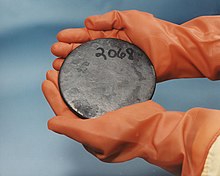 Uranium metal highly enriched in uranium-235 | |
| General | |
|---|---|
| Symbol | 235U |
| Names | uranium-235, 235U, U-235 |
| Protons (Z) | 92 |
| Neutrons (N) | 143 |
| Nuclide data | |
| Natural abundance | 0.72% |
| Half-life (t1/2) | 703800000 years |
| Isotope mass | 235.0439299 Da |
| Spin | 7/2− |
| Excess energy | 40914.062±1.970 keV |
| Binding energy | 1783870.285±1.996 keV |
| Parent isotopes | 235Pa 235Np 239Pu |
| Decay products | 231Th |
| Decay modes | |
| Decay mode | Decay energy (MeV) |
| Alpha | 4.679 |
| Isotopes of uranium Complete table of nuclides | |
Uranium-235 (235
U
or U-235) is an isotope of uranium making up about 0.72% of natural uranium. Unlike the predominant isotope uranium-238, it is fissile, i.e., it can sustain a nuclear chain reaction. It is the only fissile isotope that exists in nature as a primordial nuclide.
Uranium-235 has a half-life of 703.8 million years. It was discovered in 1935 by Arthur Jeffrey Dempster. Its fission cross section for slow thermal neutrons is about 584.3±1 barns.[1] For fast neutrons it is on the order of 1 barn.[2] Most neutron absorptions induce fission, though a minority (about 15%) result in the formation of uranium-236.[3][4]
- ^ "#Standard Reaction: 235U(n,f)". www-nds.iaea.org. IAEA. Retrieved 4 May 2020.
- ^ ""Some Physics of Uranium", UIC.com.au". Archived from the original on July 17, 2007. Retrieved 2009-01-18.
{{cite web}}: CS1 maint: unfit URL (link) - ^ "Capture-to-fission Ratio". nuclear-power.com. Retrieved June 26, 2024.
- ^ Cabell, M. J.; Slee, L. J. (1962). "The ratio of neutron capture to fission for uranium-235". Journal of Inorganic and Nuclear Chemistry. 24 (12): 1493–1500. doi:10.1016/0022-1902(62)80002-5.